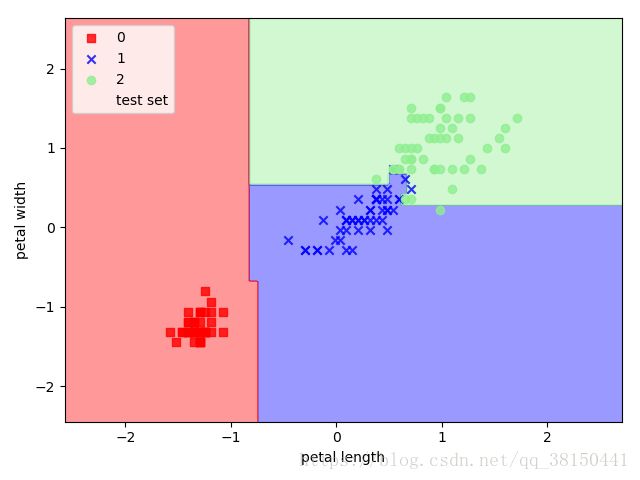PyML(五)——用sklearn训练决策树模型
1.决策树
没什么好说的,可以用graphviz(dot命令)画流程图
# -*- coding: utf-8 -*-
# @Time : 2018/7/24 9:13
# @Author : Alan
# @Email : [email protected]
# @File : decision tree_sk1.py
# @Software: PyCharm
from sklearn.tree import DecisionTreeClassifier
from sklearn import datasets
import numpy as np
import matplotlib.pyplot as plt
from sklearn.cross_validation import train_test_split
from sklearn.preprocessing import StandardScaler
from matplotlib.colors import ListedColormap
from sklearn.tree import export_graphviz
iris = datasets.load_iris()
X = iris.data[:,[2,3]]
y = iris.target
X_train,X_test,y_train,y_test = train_test_split(X,y,test_size=0.3,random_state = 0)
sc = StandardScaler()
sc.fit(X_train)
X_train_std = sc.transform(X_train)
X_test_std = sc.transform(X_test)
X_combined_std = np.vstack((X_train_std,X_test_std))
y_combined_std = np.hstack((y_train,y_test))
def plot_decision_regions(X, y, classifier,test_idx=None, resolution=0.02):
# setup marker generator and color map
markers = ('s', 'x', 'o', '^', 'v')
colors = ('red', 'blue', 'lightgreen', 'cyan','gray')
cmap = ListedColormap(colors[:len(np.unique(y))])
# plot the decision surface
x1_min, x1_max = X[:, 0].min() - 1, X[:, 0].max() + 1
x2_min, x2_max = X[:, 1].min() - 1, X[:, 1].max() + 1
xx1, xx2 = np.meshgrid(np.arange(x1_min, x1_max, resolution),
np.arange(x2_min, x2_max, resolution))
Z = classifier.predict(np.array([xx1.ravel(), xx2.ravel()]).T)
Z = Z.reshape(xx1.shape)
plt.contourf(xx1, xx2, Z, alpha=0.4, cmap=cmap)
plt.xlim(xx1.min(), xx1.max())
plt.ylim(xx2.min(), xx2.max())
# plot all samples
#X_test, y_test = X[test_idx, :], y[test_idx]
for idx, cl in enumerate(np.unique(y)):
plt.scatter(x=X[y == cl, 0], y=X[y == cl, 1],
alpha=0.8, c=cmap(idx),
marker=markers[idx], label=cl)
# highlight test samples
if test_idx:
X_test, y_test = X[test_idx, :], y[test_idx]
plt.scatter(X_test[:,0], X_test[:,1], c='',
alpha=1.0, linewidth=1, marker='o',
s=55, label='test set')
tree = DecisionTreeClassifier(criterion='entropy',max_depth=3,random_state=0)
tree.fit(X_train_std,y_train)
plot_decision_regions(X_combined_std,y_combined_std,classifier=tree,test_idx=range(105,150))
plt.xlabel('petal length [cm]')
plt.ylabel('petal width [cm]')
plt.legend(loc='upper left')
plt.show()
export_graphviz(tree,out_file='tree.dot',feature_names=['petal length','petal width'])
2.随机森林
random forest一大优点是受超参数的影响波动不是很大,但是几个主要参数还是需要好好调参的。比如说:在实际运用随机森林模型时,树的数目(k)需要好好调参。一般,k越大,随机森林的性能越好,当然计算成本也越高。
# -*- coding: utf-8 -*-
# @Time : 2018/7/24 10:41
# @Author : Alan
# @Email : [email protected]
# @File : decision_tree_sk2.py
# @Software: PyCharm
from sklearn.ensemble import RandomForestClassifier
from sklearn import datasets
import numpy as np
import matplotlib.pyplot as plt
from sklearn.cross_validation import train_test_split
from sklearn.preprocessing import StandardScaler
from matplotlib.colors import ListedColormap
from sklearn.tree import export_graphviz
iris = datasets.load_iris()
X = iris.data[:,[2,3]]
y = iris.target
X_train,X_test,y_train,y_test = train_test_split(X,y,test_size=0.3,random_state = 0)
sc = StandardScaler()
sc.fit(X_train)
X_train_std = sc.transform(X_train)
X_test_std = sc.transform(X_test)
X_combined_std = np.vstack((X_train_std,X_test_std))
y_combined_std = np.hstack((y_train,y_test))
def plot_decision_regions(X, y, classifier,test_idx=None, resolution=0.02):
# setup marker generator and color map
markers = ('s', 'x', 'o', '^', 'v')
colors = ('red', 'blue', 'lightgreen', 'cyan','gray')
cmap = ListedColormap(colors[:len(np.unique(y))])
# plot the decision surface
x1_min, x1_max = X[:, 0].min() - 1, X[:, 0].max() + 1
x2_min, x2_max = X[:, 1].min() - 1, X[:, 1].max() + 1
xx1, xx2 = np.meshgrid(np.arange(x1_min, x1_max, resolution),
np.arange(x2_min, x2_max, resolution))
Z = classifier.predict(np.array([xx1.ravel(), xx2.ravel()]).T)
Z = Z.reshape(xx1.shape)
plt.contourf(xx1, xx2, Z, alpha=0.4, cmap=cmap)
plt.xlim(xx1.min(), xx1.max())
plt.ylim(xx2.min(), xx2.max())
# plot all samples
#X_test, y_test = X[test_idx, :], y[test_idx]
for idx, cl in enumerate(np.unique(y)):
plt.scatter(x=X[y == cl, 0], y=X[y == cl, 1],
alpha=0.8, c=cmap(idx),
marker=markers[idx], label=cl)
# highlight test samples
if test_idx:
X_test, y_test = X[test_idx, :], y[test_idx]
plt.scatter(X_test[:,0], X_test[:,1], c='',
alpha=1.0, linewidth=1, marker='o',
s=55, label='test set')
forest = RandomForestClassifier(criterion='entropy',n_estimators=10,random_state=1,n_jobs=2)
forest.fit(X_train_std,y_train)
plot_decision_regions(X_combined_std, y_combined_std,classifier=forest, test_idx=range(105,150))
plt.xlabel('petal length')
plt.ylabel('petal width')
plt.legend(loc='upper left')
plt.show()reference:
《python machine learning》

